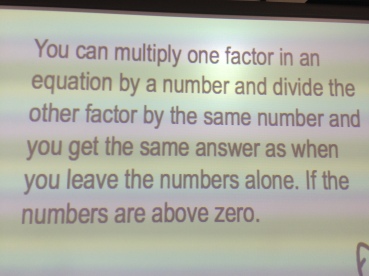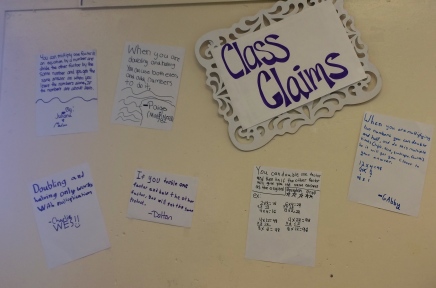This summer I was fortunate to hear Virginia Bastable keynote about the work in her book Connecting Arithmetic to Algebra. If you have not read this book, it is a must! It explores the process by which we have students notice regularities, articulate claims, create arguments and representations, and make generalizations.
 It is something, as elementary school teachers, we need to really be thinking about more in our math classes. Are we creating environments that encourage students to think about the math behind the strategies and make generalizations based on the properties of operations? I have taken this recent reading and made it a priority in my classroom.
It is something, as elementary school teachers, we need to really be thinking about more in our math classes. Are we creating environments that encourage students to think about the math behind the strategies and make generalizations based on the properties of operations? I have taken this recent reading and made it a priority in my classroom.
I always have students notice and discuss patterns and regularities but I don’t often have them create generalizations for us to revisit as we move through the year. For example if their claim works for whole numbers, shouldn’t I revisit that as we work with fractions? Does your claim still hold true?
As a class routine, I posted this on the board and asked students to fill in the blanks to make it true:
12 x 4 = ___ x ____
Quickly, students wrote down answers, had their hands up, and one student blurted, “This is easy, you don’t even have to solve it!” Typically blurting out answers before others are done thinking drives me a bit crazy, but this time I was thinking…Yes! I asked who else thought the same thing. I had at least one hand up at each table so I asked them to discuss with their table how that is possible. We came back together and each table said they could double/half to fill in the blanks. I took answers on the board and got the expected: 6 x 8, 24 x 2, 48 x 1, 3 x 16 and then I even had a 96 x 1/2 and 36 x 1 1/3! I asked about the 48 x 1…did you get that by double/halving from the original problem? What is happening there? They noticed that it was x 4, ÷ 4, and then the same with 3 x 16. I asked them to take some individual time to see if they thought their strategy would always work and could prove it with a representation. They then talked at their tables and I asked each table to write a claim, something they think is true about this work.
I got some who kept solving problems to prove it works:
I had a couple try out the representation (exclaiming how hard it was to draw what is happening:)
Here are some of their claims:
This is the class list from my second period class. I especially liked that one of them said it only worked with multiplication. How fun to revisit!
 Instead of losing these, I started a Claim Wall to post and have students add to and revisit throughout the year. I am trying to think through how to have students comment on them, possibly agree/disagree post its?
Instead of losing these, I started a Claim Wall to post and have students add to and revisit throughout the year. I am trying to think through how to have students comment on them, possibly agree/disagree post its?
If you would like more information about Virginia’s work, there are courses available here: http://mathleadership.org/programs/online-courses/ Check it out, great stuff!
-Kristin












LOVE the claims wall! Lots of mathematical sweating for your kiddos! Intrigued by the even and odd thread and looking forward to hearing how that plays out!
LikeLike
Great!
I really like the look of the book, and have just read the first chapter here:
Click to access russellwebsample.pdf
The Class Claims board is a great idea! Yes post-its to challenge, affirm qualify. How big, paper-size-wise are the claims? If they are nice and big they won’t get swamped by the post-its (and shortsighted people like me can see them from a distance).
LikeLike
I really like the idea of the claim board! I think its great for students to add and revisit this through the year! One question I have is how big is the claim board and do you add after each lesson to this cause then it might get too crowded! I really wanna use this in my class so any suggestion as to how to set it up would be great!
Thanks
LikeLike
Thanks so much! This is my first time with this board, so I am learning as I go too! It is a very large wall in my room which is nice that I have the space. I definitely will not add after each lesson bc they notice sooo many things, you are right, it would be too crowded! I was thinking that common noticings that occur over and over again, could develop into a claim. I also am thinking that I will keep it focused on number and properties of operations this year. I would love any thoughts you have too!
LikeLike
I like the claims wall and always enjoy seeing samples of student work. I can tell they are really thinking through the process. Thank you for sharing your students’ experience! I plan to share with my teachers. Have a great weekend!
LikeLike
Pingback: Number Routine PD: What Do I Know About… | Math Minds
Pingback: Math Class Through My Students’ Eyes… | Math Minds
Pingback: Supporting Mathematical Habits of Mind | MathMinds